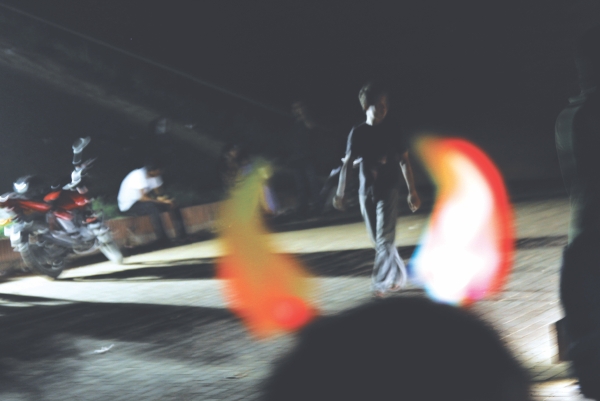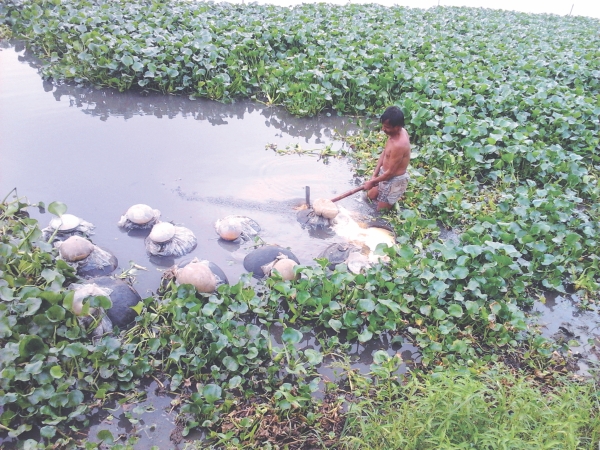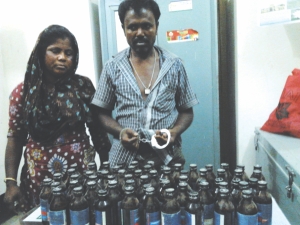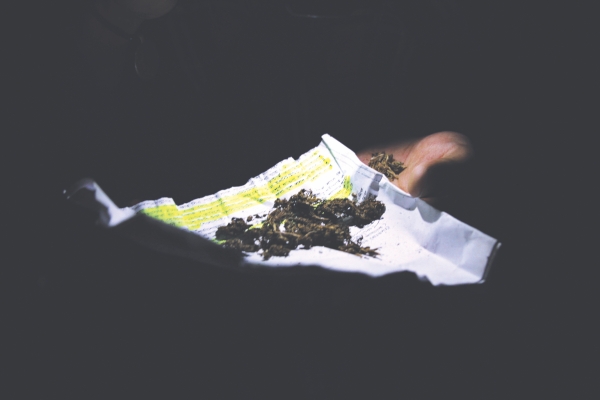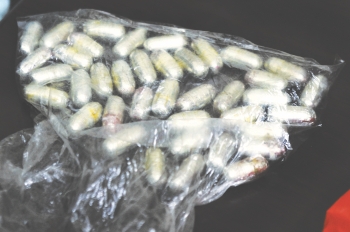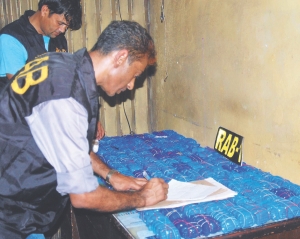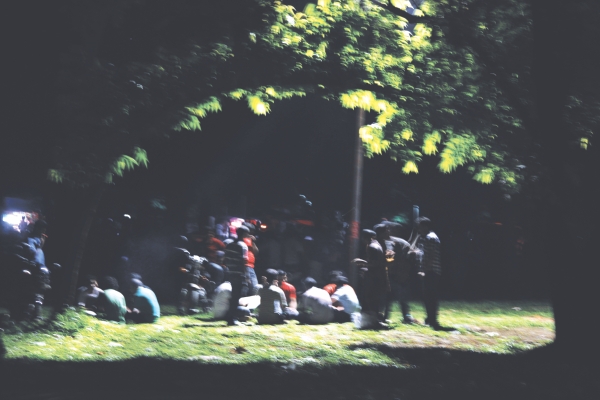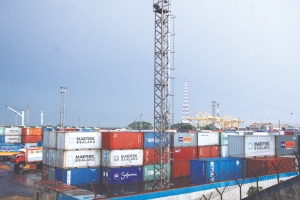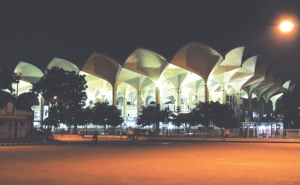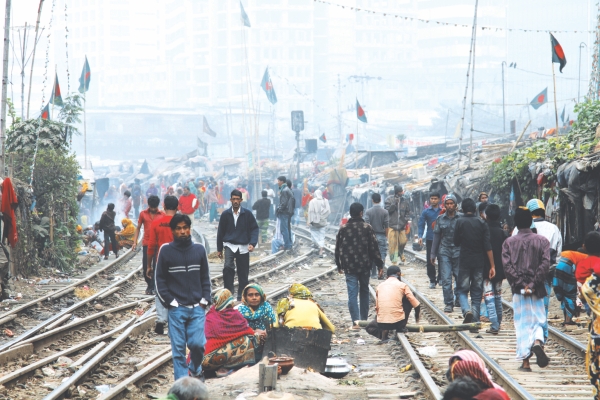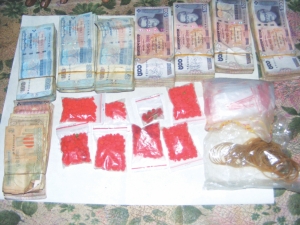| Home - Back Issues - The Team - Contact Us |
 |
| Volume 11 |Issue 22| June 01, 2012 | |
|
|
Cover Story
Chasing the Dragon Sushmita S Preetha Innovative, efficient and ruthless, it doesn't understand morals, only money. The drug trade in Bangladesh is a multi-million dollar industry that involves a wide range of players, from poor women and children to law enforcement agencies and crime syndicates. It is an organised system with myriad networks that extend all throughout the country and beyond to ensure the safe movement of illicit drugs from producers to consumers. In recent years, drug abuse has emerged as a crucial social issue, affecting the lives of more than 4.6 million regular users. Despite efforts to curb the flow of drugs from both within and outside of the country, the drug trade is now thriving, with drugs such as phensedyl, heroin, cannabis and yaba being imported, manufactured, transported, stored and sold.
Bangladesh is not a major drug producing country, but its geographical position makes it particularly vulnerable to drug trade. It is located in the middle of two of the world's largest narcotics producing belts – the Golden Triangle (Myanmar, Thailand, Vietnam and Laos) and the Golden Crescent (Afghanistan, Iran and Pakistan). Meanwhile, its neighbour, India, is the largest licit opium producing country in the world. “Opium, heroin, phensedyl, cannabis and buprenorphine are smuggled in bulk from India while yaba is supplied by Myanmar. Small amounts of cannabis also come from Nepal and Bhutan,” explains Khondker Mohammad Ali, Director General of the Department of Narcotics Control (DNC). The small towns and trade centres near the borders are used as transit points, and to avoid detection, smugglers prefer to use jungles, canals or rivers rather than roads and highways. According to various sources, there are as many as 2,000 phensedyl factories and warehouses in the border areas of Assam and West Bengal. Thousands of bottles are smuggled every night by a large number of both Bangladeshi and Indian men, women and children as carriers, and stored in warehouses till their dispatch. Indian drug traders have capitalised on the ban on phensedyl since the 1980s, often mixing it with strong sedatives and other chemicals. The DNC, however, denies the existence of these phensedyl factories along the border, stating that investigations by both Indian and Bangladeshi officials have produced no conclusive results.
The highly profitable nature of drug smuggling means that a significant number of people in the coastal regions and border areas of the country are involved in the trade. Ali claims that an overwhelming number of people in Teknaf, Cox's Bazar and islands in the Bay of Bengal are somehow or the other implicated in the crime. Fifty godfathers operate drug businesses in Ukhiya, Teknaf and Bandarban; in Teknaf alone, there are 20 influential syndicates. Often, women and children are used to smuggle drugs because they get sympathy from border guards if caught. Ashraf (not his real name) is 15-years-old and has been smuggling goods across the border since he was eight. “One of my uncles came and asked me if I wanted to earn some money. I come from a very needy family, so I jumped at the offer. All I'd have to do is carry a package from one end of the jungle to the other,” remembers Ashraf. He admits to being caught a couple of times by border guards, but says they let him off with a good beating. “We constantly change routes to avoid capture,” he says. After seven years of working for other people for minimum pay, Ashraf now wants to have a business of his own and become a supplier himself. “It's much more than what I could have done had I gone to school,” he says proudly. Meanwhile, the yaba pills from Myanmar are mainly smuggled by the Rohingya and Mog people through the mostly porous borders. According to an intelligence report, at least 13 syndicates are active in the bordering areas and 131 syndicates trade in and supply the pills across the country. There are thousands of traffickers who operate within Bangladesh, carrying goods from the main entry points to Dhaka and other destinations. Using road, rail and river, the traffickers transport goods in highly innovative ways. Small consignments of drugs are usually concealed on a person's body. Women, in particular, are engaged in these activities, for they can hide small amounts of heroin, phensedyl, cannabis and yaba in their undergarments, luggage, special belts, jackets, shoes, corset belts etc. They can also pretend to be pregnant and carry goods under a burqah. A woman can carry up to 20 kg of heroin, 10 kg of cannabis or up to 70 bottles of phensedyl. Meanwhile, medium to large consignments are concealed in a variety of ways. They are hidden in rice, paddy, fruits, vegetables, fish, eggs, coffins, gas cylinders, toothpaste, hollow chambers of wood, soap bars etc. The DNC even found drugs concealed in the stomachs of cows, especially in those transported from India. “One has to be creative to avoid exposure,” says Motin (not his real name), a dealer. “The law enforcement agencies are becoming smarter and more thorough in their searches, so we have to become better, too. For instance, I use cavities – false compartments – in my microbus that are specially designed and can only be taken apart by a professional mechanic, but I've noticed the suspicion of the police when they stop to search,” comments Motin. He says he has a few new tricks up his sleeves, but smiles indulgently when asked to share them. Although the roads and highways are most popular for transporting goods within the country, sea and air routes are also used for the shipment of goods to Europe and the USA. The waters of Bay of Bengal are especially convenient for the transportation of drugs from countries in the Golden Triangle because of its strategic location.
Bangladesh does not produce any major drug, according to official statements, except for negligible amounts of cannabis. In reality, cannabis is grown in different parts of the country, particularly in remote rural and hilly areas – in home yards, gardens and farm lands. Various local users and dealers state that yaba is now being locally manufactured, but the law enforcement agencies categorically refute such claims. The abuse of opium and morphine today in Bangladesh is negligible, but the abuse and trafficking of heroin and phensedyl is a major concern. Introduced in the 1990s, the two drugs, particularly, phensedyl, have enjoyed tremendous popularity and given rise to generations of addicts. Phensedyl, which is legally produced and sold in India, is the number one smuggled item from the Bangladesh's neighbour. A bottle priced at Tk. 200 near the border costs at least Tk. 1,000 by the time it reaches the consumer. Meanwhile, although cannabis (which was once produced under government control) was banned in the 1980s, its use has only increased over time, considering the scarcity of phensedyl.
The introduction of yaba in recent years has changed the drug scenario in Bangladesh and it continues to increase in popularity at an alarming rate, especially among affluent circles. It's expensive, highly addictive and very harmful. A yaba pill costing Tk. 30 or less is sold in Dhaka and neighbouring areas for as much as Tk. 600. On the other hand, dandy, an adhesive containing toluene, is another drug that has recently emerged in the streets of Dhaka. Street children in Dhaka and other major cities have started to sniff or inhale the odour of adhesives that are usually used for industrial or household purposes. It's cheaper than food and enables them to feel “full” on an empty stomach.
The wholesalers of cannabis, phensedyl, heroin and yaba are usually former vendors of cannabis, local goons, associates of various crime lords or people involved with the smuggling of other illegal commodities. The carriers, as mentioned previously, are mainly people from underprivileged groups, including women and children, who can be easily lured into making money despite the high risks involved. “A labourer gets maximum Tk. 200 by working all day in the sun, while carrying drugs can fetch a person Tk. 800 or more. So they are willing to undergo tremendous risks,” opines Ali. Marginalised groups are also involved in drug peddling and selling, and are often recruited by the drug dealers, for they are cheap, easily available and exploitable. Many children support their entire families with the earnings from drug peddling and act as mobile drug shops. Sometimes, whole families are engaged in the trade. A large number of drug sellers and retailers are abusers themselves and take up drug dealing as a means to sustain their own addiction. Others, however, get into the trade because of its profitability. Alamgir (not his real name), for instance, was a mechanic earning Tk. 400 per day on average, when he was approached by one his regular customers – a “choto bhai”. “He said I'd have to pick up a package from a particular place and deliver them to a few destinations around the city. In return, he would pay me a handsome amount. By the end of the two years, I knew all his contacts, so I began to buy yaba and sell them myself.” Now Alamgir earns on average Tk. 5,000 everyday and has a client base of 20 regulars who buy from him every two days, if not daily. Traditionally, it was people from working class or lower middle class who were involved in drug dealing. Nowadays, however, students and teenagers from affluent families have also started to engage in the trading of yaba, in their desperation to maintain their drug addiction and/or to make quick money. Many school students, typically in high schools, push drugs within their schools.
Law enforcement agencies, military personnel, political elite, a number of godfathers and ward commissioners are also engaged in the drug trade in some capacity or another. Most major drug dealers have connections with the police and pay them regular bribes to stay in their good books. In fact, the sale of many of these drugs happens under the noses of officials. Even when the dealers are caught, they usually get out with bail or because of loopholes in police records. The DNC, however, denies the allegations of corruption and misconduct on the part of law enforcement agencies, saying that, except for a few exceptions, they are sincere about eradicating drug abuse from Bangladesh. Ali maintains that it is impossible to control the drug trade with 700 personnel, only 300 of whom are field agents. “With such limited resources, we simply cannot challenge the organised way drug trafficking happens in this country,” he says.
It is assumed that the drugs recovered from the DNC constitute roughly 10 percent of all drugs that come into the country, although it is impossible to deduce the total quantity. According to official statistics (which are conservative, at best), at least 100,000 people are involved and more than 25 crore taka are spent each year in drug trafficking. Meanwhile, crime reports suggest that approximately 30 percent of all criminal offences pertain to drugs, and as much as 70 percent of crimes are directly or indirectly related to drugs. Theft, robbery, extortion, kidnapping, assault and murder also transpire in connection to the drug trade. “People in the drug trade can be ruthless, depending on what is at stake. They are capable of doing the unthinkable and have no moral qualms in 'getting rid' of people considered to be 'enemy' or 'traitors',” admits a drug peddler who wishes to remain unnamed. Just this week, an A-level student, Himadri Majumdar Himu was brutally tortured and ultimately murdered for trying to stop the drug peddling of four of his friends. They set large Doberman dogs on him and then threw him off the rooftop of a building to ensure his death. Drug trafficking is a dangerous and often merciless business. Multifaceted factors are responsible for the ongoing drug trade and abuse – Bangladesh's geographical position, diplomatic stance vis-à-vis its neighbours, poverty, exploitation, corruption, poor governance, the deteriorating law and order situation as well as changes in culture and people's perceptions. This makes it one of the most difficult evils in society to address and eliminate. Catching drug traffickers through sporadic raids is not the answer. The state needs to adopt a holistic approach, starting with understanding the motivations behind those engaged in the trade. Until then, we are miles away from preventing drugs from spreading its toxic tentacles all over society.
|
||||||||||||||||||||||||
Copyright
(R) thedailystar.net 2012 |
